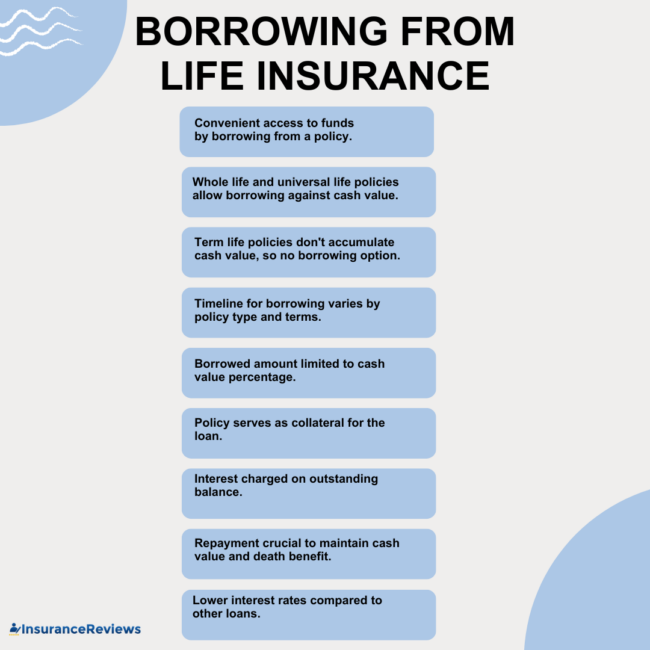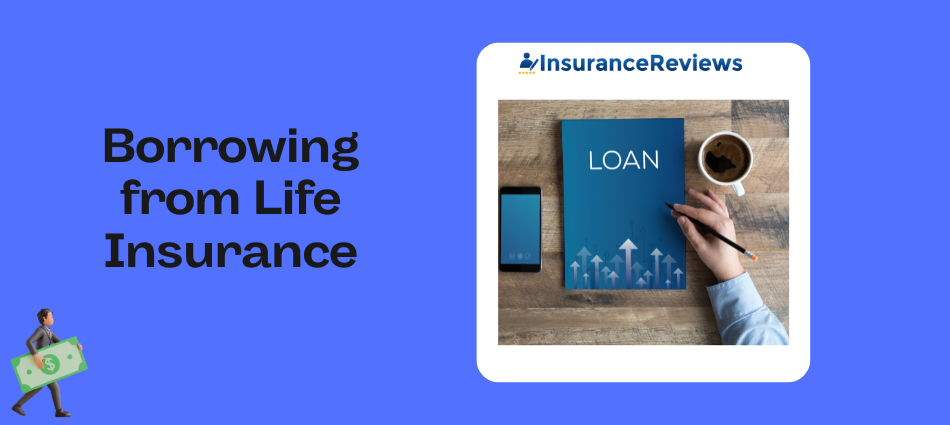When seeking capital, there are typically several options available. In the context of Life Insurance, certain policies provide the opportunity to borrow funds instead of approaching a traditional lender such as a bank.
Borrowing money from your life insurance policy can be an effective way to access fast cash when you need it the most.
However, this option is only available for specific types of policies, such as whole life insurance or universal life insurance.
In order to have the option of borrowing money from a Life Insurance policy, it is necessary to have a policy that includes a cash-value component. This cash-value component allows the policyholder to accumulate savings within the policy, which can then be accessed through borrowing against it, and in some cases, without affecting the death benefit for your beneficiaries.
Before you consider borrowing against your policy, it’s essential to understand how it works and the potential consequences of doing so. Generally, the amount you can borrow is determined by a percentage of your policy’s cash value, with each insurance company having its own set of rules and regulations regarding the process.
It’s usually easier to borrow from your insurance policy than obtain a loan through traditional means, as there are no credit checks involved, and interest rates are often lower than what you’d encounter with bank loans or credit cards.
Keep in mind that borrowing from your life insurance may impact the overall value of your policy and the benefits your beneficiaries receive upon your death. It’s crucial to weigh the pros and cons carefully, some of which will be discussed in this article, and consult an insurance expert or financial advisor if necessary, before proceeding with this decision.

Key Takeaways
- Borrowing from a life insurance policy can provide a convenient way to access funds when needed, but it’s important to understand the implications and potential consequences.
- Whole life insurance and universal life insurance policies offer the option to borrow against the cash value, while term life insurance policies do not accumulate cash value and therefore cannot be borrowed against.
- The timeline for borrowing against a life insurance policy depends on the policy type and specific terms. Whole life policies typically require a few years of ownership before borrowing is allowed.
- When borrowing against a life insurance policy, the borrowed amount is typically limited to a percentage of the cash value, and the policy itself serves as collateral for the loan.
- Interest is charged on the outstanding loan balance, which can reduce the policy’s cash value if not repaid. Failure to repay the loan may also impact the death benefit for beneficiaries.
- Life insurance loans often have lower interest rates compared to other types of loans, making them a potentially cost-effective option for accessing funds.
- Before making a decision to borrow against a life insurance policy, carefully weigh the pros and cons, consider the long-term impact on the policy’s value and death benefit, and consult with an insurance expert or financial advisor if needed.
How Soon Can You Borrow Against a Life Insurance Policy?
The timeline for when you can borrow against a life insurance policy depends on the type of policy you have. For whole life insurance policies, you can typically borrow against the cash value after a few years of ownership. The specific timeframe may vary, so it’s important to review your policy or consult with your insurance company for the exact eligibility requirements.
Universal life insurance policies offer more flexibility, and the timeline for borrowing varies based on the policy’s structure and terms.
On the other hand, term life insurance policies do not accumulate cash value, which means there is no borrowing option available.
It’s crucial to understand the specific guidelines and timeframes set by your insurance policy to determine when you can access funds through borrowing.
| Policy Type | Timeframe to Borrow |
| Whole Life | Typically after a few years of ownership |
| Universal Life | Varies depending on the policy |
| Term Life | No borrowing option available |
Types of Life Insurance Policies
Life insurance policies come in different forms, and not all of these policies offer the possibility of borrowing funds. This section will discuss the two primary types of life insurance: whole life insurance and term life insurance, and the options for borrowing from each.
Whole Life Insurance
Whole life insurance is a type of permanent life insurance policy that provides coverage for the lifetime of the insured person. It has a cash value component, which grows over time, and can be borrowed against. Whole life insurance policies allow you to make tax-free withdrawals or take loans against the cash value of the policy. Loans from your whole life insurance policy typically carry low-interest rates and do not impact your credit score.
Here’s a brief overview of borrowing from a whole life insurance policy:
- Tax-free loans
- Low-interest rates
- Does not impact credit score
If you have a whole life insurance policy and want to borrow against the cash value, you should check the details of your policy or contact your insurance company for specific loan terms and conditions.
Keep in mind that outstanding loans do accrue interest, which can reduce the death benefit and cash value if not paid back.
Term Life Insurance
Term life insurance, on the other hand, is a temporary form of life insurance that provides coverage for a specific number of years or term. Term life insurance policies do not build cash value, meaning you cannot borrow money from them. These policies generally only offer death benefits for the beneficiaries, without the option to access funds during the policyholder’s lifetime.
In summary, only whole life insurance policies provide the option to borrow from the cash value, while term life insurance does not. To determine your options for borrowing, always refer to the specific details of your policy and consult with your insurance company regarding the available options.
Borrowing from Life Insurance
The Process of Borrowing
Borrowing from your life insurance policy can be a convenient way to access funds when you need them. This option is only available for whole life insurance policies or universal life insurance policies. To begin the process, you will need to contact your insurance company to discuss the specific steps and requirements. In most cases, they will guide you through the process and provide you with any necessary paperwork to complete. It’s important to remember that when you’re borrowing from your life insurance policy, you’re actually borrowing your own money and using the cash value of your policy as collateral source.
How Much Can Be Borrowed
The amount you can borrow from your life insurance policy varies based on the insurer’s rules and the cash value accumulated in your policy. Generally, the maximum policy loan amount is at least 90% of the cash value, with no minimum amount required (source). Keep in mind that your policy’s cash value typically builds up over time, so the longer you’ve had the policy, the more you may be able to borrow.
How Soon Can You Borrow
The timeline to borrow from your life insurance policy depends on its cash surrender value, which grows over time. The cash surrender value is the amount you’d receive if you were to cancel the policy before its maturity. Some policies may require a specific period, such as a few years, before being eligible for a loan. It’s essential to review your policy’s specific terms or speak with your insurance company to determine how soon you can borrow from your life insurance policy (source).
Pros and Cons
When considering borrowing from your life insurance policy, it’s essential to weigh the pros and cons to make an informed decision. Here, we’ll outline some of the advantages and disadvantages of taking such a loan.
Pros
- No Income Tax: Money you borrow from your life insurance policy is not taxed as income, giving you greater financial flexibility in using the funds (source).
- No Credit Check Required: Since the loan is based on your policy’s cash value, there’s no need for a credit check, making the process hassle-free (source).
- Flexible Repayment Schedule: You can choose when to repay your loan instead of being tied to a strict repayment schedule, making it easier to manage your finances (source).
Cons
- Reduced Death Benefit: If you do not pay back the loan, the remaining balance will be deducted from the death benefit, leaving your beneficiaries with a smaller payout (source).
- Policy Lapse Risk: If your loan amount exceeds your cash value or you fail to pay your premiums on time, your life insurance coverage may lapse, leaving you without protection (source).
- Loan Interest: Borrowing from your life insurance policy isn’t interest-free. If you don’t repay the loan quickly, the interest can compound and increase the amount you owe, impacting both your cash value and death benefit (source).
When considering borrowing from your life insurance policy, carefully assess these pros and cons to determine if it’s the right option for your financial needs.
Borrowing From Life Insurance Policy – FAQs
No, term life insurance policies do not accumulate cash value and therefore cannot be borrowed against. Only permanent life insurance policies, such as whole life or universal life insurance, have cash value that can be accessed through borrowing.
The timeline for receiving the borrowed funds can vary depending on the insurance company and their processing time. It is best to inquire with your insurance company about the expected timeframe.
In most cases, you can borrow multiple times from your life insurance policy as long as there is available cash value. However, each loan may have its own terms and conditions, including interest rates and repayment options.
If you surrender your life insurance policy with an outstanding loan, the remaining loan balance will be deducted from the cash surrender value before you receive any remaining funds.
The ability to borrow against a life insurance policy owned by a trust may depend on the terms and conditions set within the trust. It’s advisable to consult with your insurance company and legal advisor to understand the specific rules and options regarding borrowing against a trust-owned policy.
Summary
A life insurance loan is a unique borrowing option that allows policyholders to access the cash value of their life insurance policy while still alive. This type of loan is available for permanent life insurance policies, such as whole life or universal life, which accumulate cash value over time. Ensure eligibility and understand the process before making a decision.
Unlike traditional loans, there is no need for a credit check or repayment schedule, as the loan is ultimately repaid through the policy’s death benefit. Interest is charged on the outstanding loan balance, which reduces the policy’s cash value. Policyholders have the flexibility to repay the loan at any time or even choose to never repay it, though interest continues to accumulate.
It’s important to note that outstanding loans can reduce the death benefit if not repaid, and policyholders should carefully consider the long-term impact before deciding to borrow against their life insurance policy.





